Research on Locally Resonant Characteristics of Pipelines with Periodic Structure
Abstract
:1. Introduction
2. Theory and Mathematical Modeling
2.1. Computing Method of Band Gap
2.2. Calculation Method of the Vibration Response
2.3. Evaluation Method of the Transfer Characteristics of Periodic Structure
2.4. Structural Modeling and Experimental of Local Resonant Periodic Pipeline
3. Analysis of Band Gap Property
3.1. The Effects of the Local Resonant Layers on the Band Gap
3.2. The Effects of the Local Resonance Wall Thickness on the Band Gap
4. Analysis of Vibration Damping Performance
5. Study on the Vibration Characteristics of the Periodic Pipeline Structure of the Offshore Platform
5.1. The Modeling the Offshore Platform
5.2. Effect of Local Resonance Width on Damping Performance
6. Conclusions
- (a)
- The geometry parameters of the periodic pipeline influence the band gap initial frequency, cut-off frequency and band gap width and clearly affect the pipeline vibration loss.
- (b)
- Changing the number of layers and thickness of the local resonance allows the initial frequency of the band gap to move towards the low band while wide band gap is obtained.
- (c)
- As the height of the pipeline increases, both the pipeline input and output vibration levels decrease in turn, and the vibration difference between the two also decreases with the increasing height.
- (d)
- The cushioning performance of an offshore platform with a periodic truss structure is better than that of a traditional offshore platform. As the width of the local resonance increases, the vibration level of the offshore periodic truss platform input terminal decreases in turn, the vibration level of output terminal increases first and then decreases. The vibration level difference increases first and then decreases, and the maximum vibration isolation can reach 7.93 dB.
Author Contributions
Funding
Data Availability Statement
Conflicts of Interest
References
- Xia, Z.; Kai, J.; Wang, X.; Shao, G.; Jiang, W.; Sun, Y. Study on semi-active particle dampingtechnology for offshore platform truss structure. J. Vibroeng. 2016, 18, 4248–4260. [Google Scholar]
- Wu, Q.; Zhao, X.; He, S.; Tang, W.; Zheng, R. A Bufferable Tuned-Mass Damper of an Offshore Platform against Stroke and Response Delay Problems under Earthquake Loads. Shock. Vib. 2016, 2016, 1–12. [Google Scholar] [CrossRef]
- Leng, D.; Zhu, Z.; Xu, K.; Li, Y.; Liu, G. Vibration control of jacket offshore platform through magnetorheological elastomer (MRE) based isolation system. Appl. Ocean Res. 2021, 114, 102779. [Google Scholar] [CrossRef]
- Kandasamy, R.; Cui, F.; Townsend, N.; Foo, C.C.; Guo, J.; Shenoi, A.; Xiong, Y. A review of vibration control methods for marine offshore structures. Ocean Eng. 2016, 127, 279–297. [Google Scholar] [CrossRef]
- Liang, X. Influence of Pipeline′s Vibration Noise on Acoustic Steal Nature of Ships. Noise Vib. Control. 2010, 30, 127–128. [Google Scholar]
- Tanmoy, C.; Subrata, C. Vibration mitigation of structures subjected to random wave forces by liquid col-umn dampers. Ocean Eng. 2014, 87, 151–161. [Google Scholar]
- Laude, V.; Escalante, J.M.; Martínez, A. Effect of loss on the dispersion relation of photonic and phononicic crystals. Phys. Rev. B Condens. Matter Mater. Phys. 2013, 88, 5952–5960. [Google Scholar] [CrossRef] [Green Version]
- Deymier, P.A. (Ed.) Acoustic Metamaterials and Phononic Crystals; Springer Science & Business Media: Berlin/Heidelberg, Germany, 2013; Volume 173. [Google Scholar]
- Wang, S.; Xu, M.; Xia, Z.; Li, Y. A novel Tikhonov regularization-based iterative method for structural damage identifi-cation of offshore platforms. J. Mar. Sci. Technol. 2019, 22, 575–592. [Google Scholar] [CrossRef]
- Sigalas, M.; Economou, E.N. Band structure of elastic waves in two dimensional systems. Solid State Commun. 1993, 86, 141–143. [Google Scholar] [CrossRef]
- Yang, S.; Page, J.H. Focusing of Sound in a 3D Phononicic Crystal. Phys. Rev. Lett. 2004, 93, 024301. [Google Scholar] [CrossRef] [PubMed] [Green Version]
- Bi, K.; Hong, H. Using pipe-in-pipe systems for subsea pipeline vibration control. Eng. Struct. 2016, 109, 75–84. [Google Scholar] [CrossRef] [Green Version]
- Shen, H.; Wen, J.; Yu, D.; Wen, X. Bandgap Characteristics and Transmission Characteristics of Bending Vibration of Periodic Liquid Filled Pipelines Based on Timoshenko Beam Model. Acta Phys. Sin. 2009, 58, 8357–8363. [Google Scholar]
- Koo, G.H.; Park, Y.S. Vibration reduction by using periodic supports in a piping system. J. Sound Vib. 1998, 210, 53–68. [Google Scholar] [CrossRef]
- Wen, W.G. Study on the vibration band gap and damping characteristics of phononicic crystals. Chin. Sci. Tech. Sci. 2007, 37, 1126. [Google Scholar]
- Li, S.; Dou, Y. The formation mechanism of low frequency band gap in phononicic crystal plate. J. Xi′an Jiao Tong Univ. 2018, 52, 159–166. [Google Scholar]
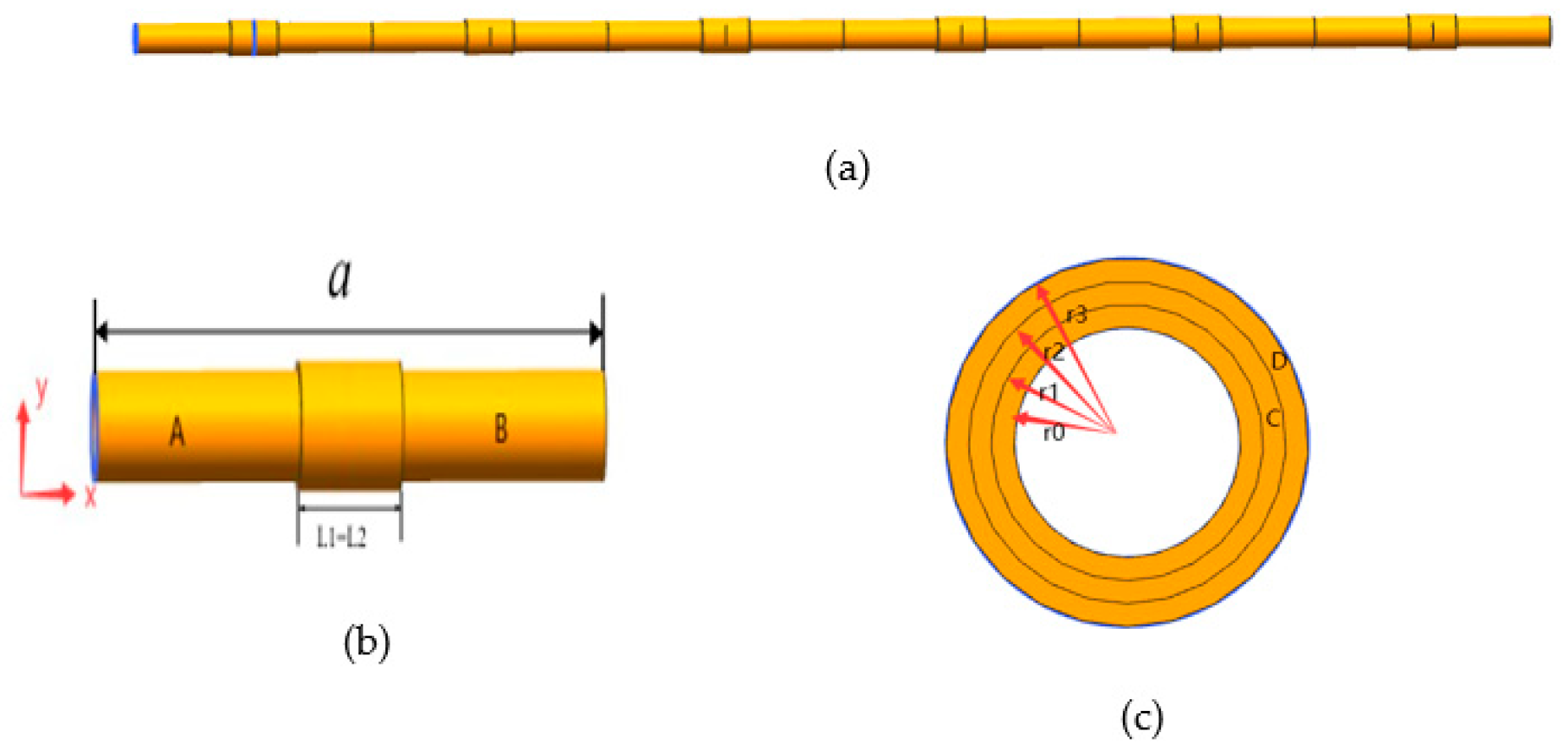
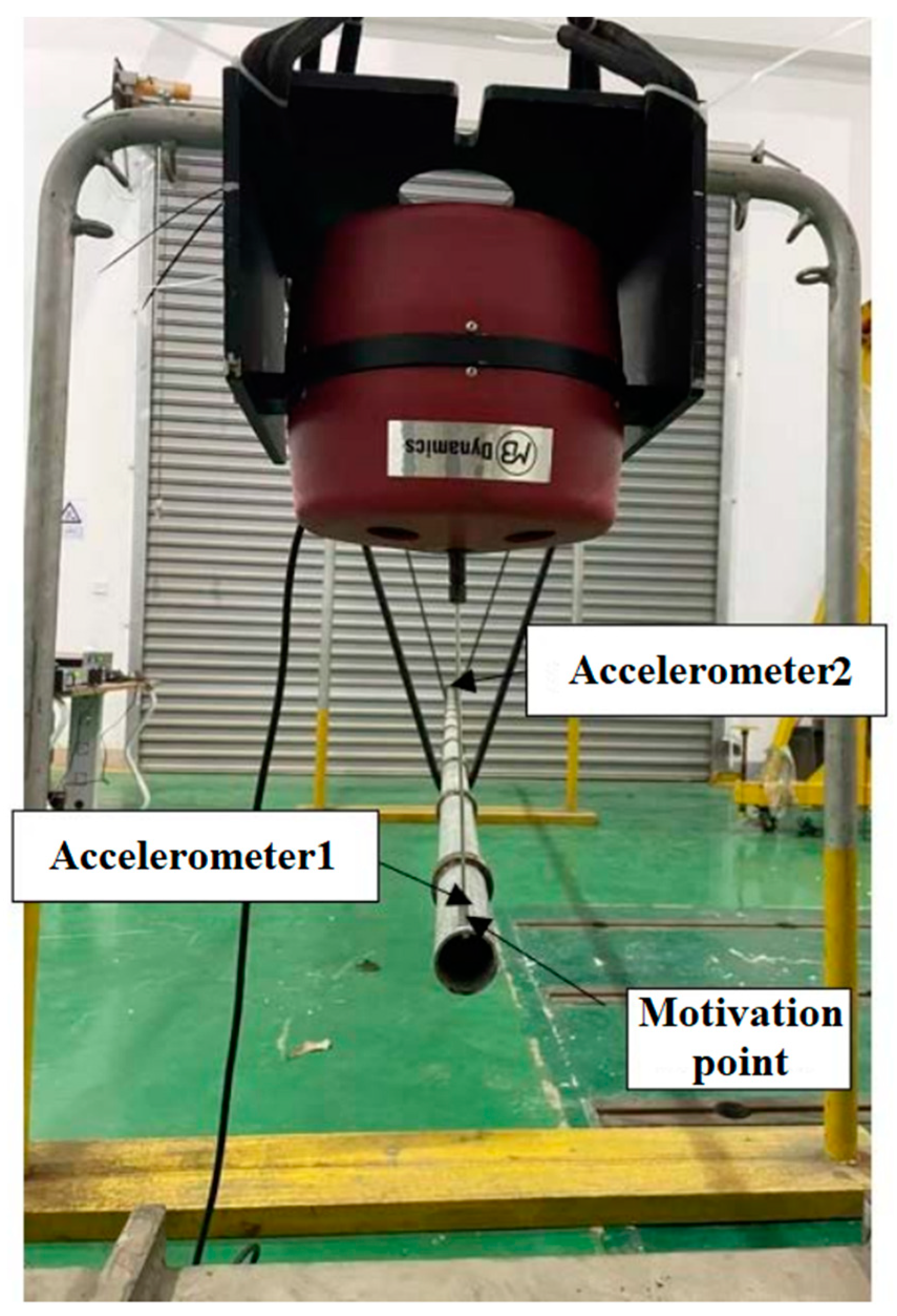
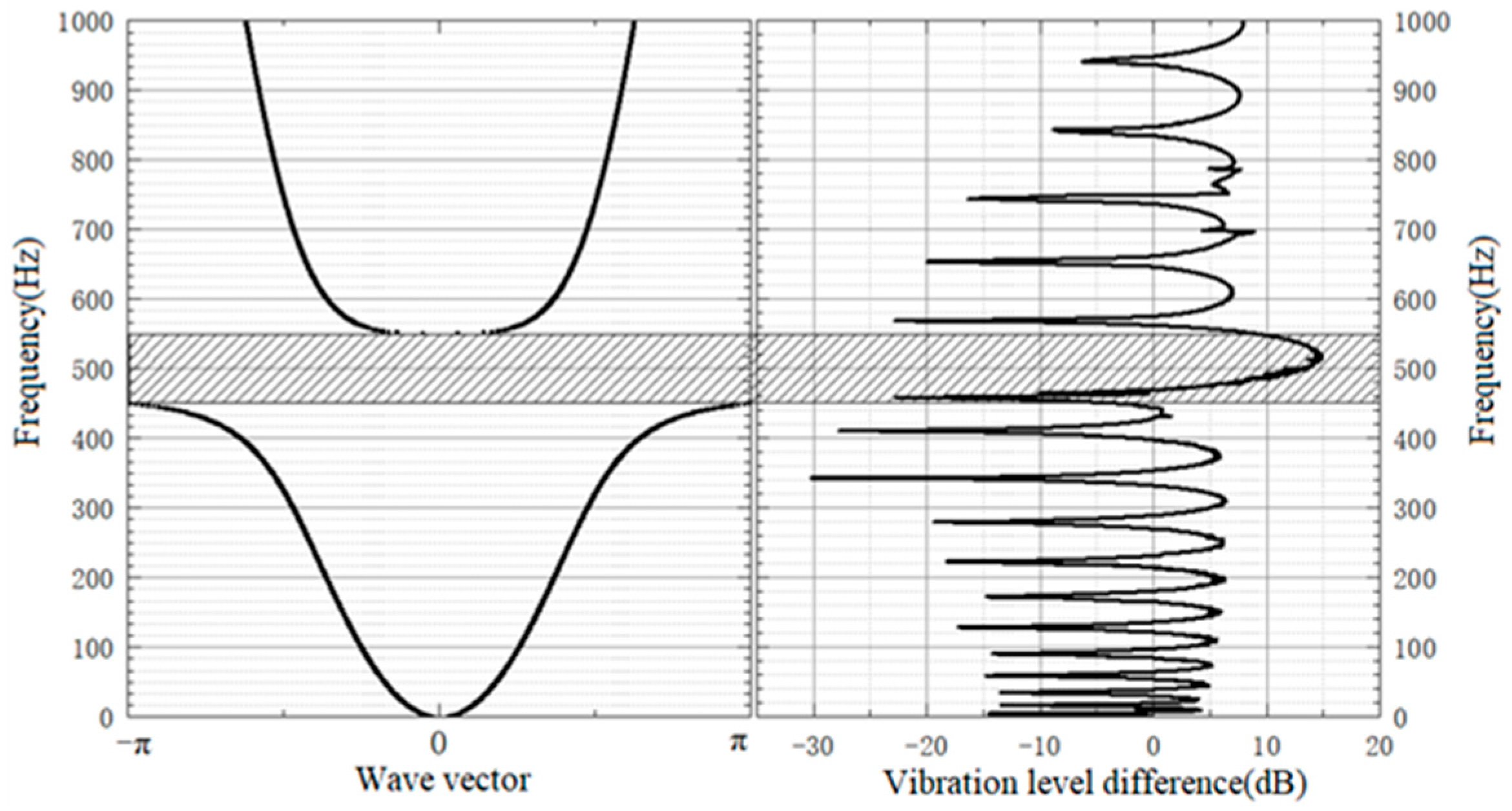
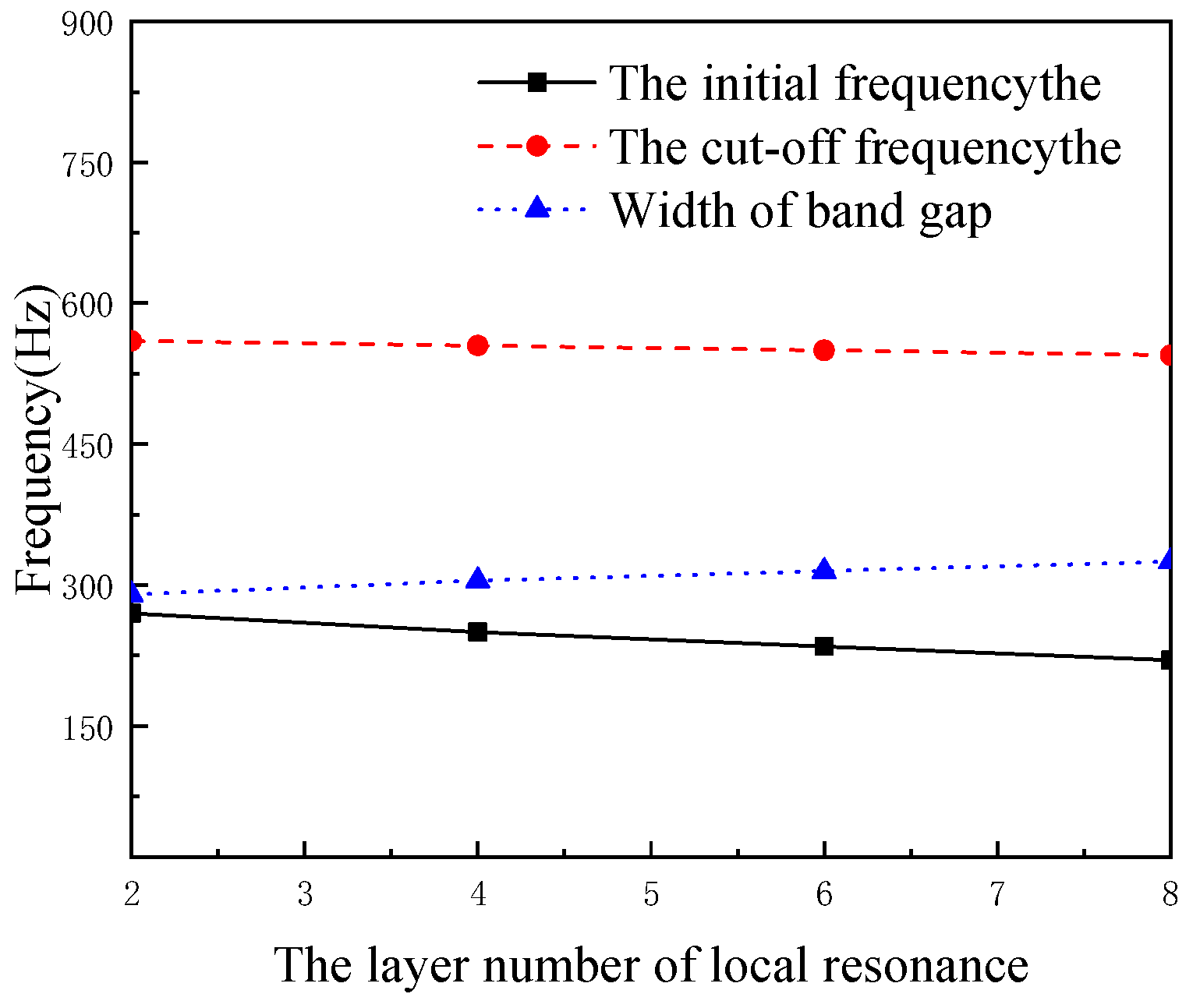
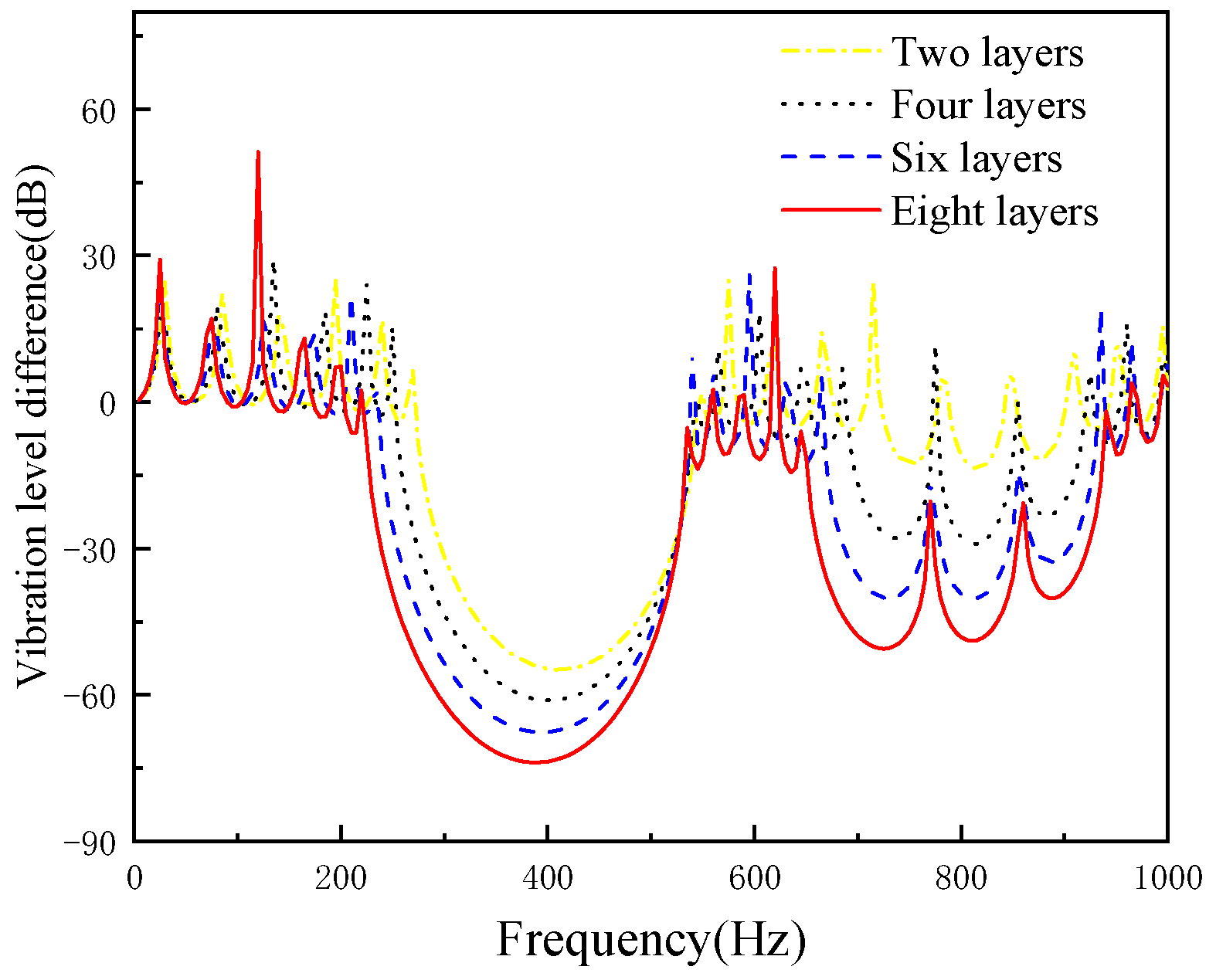
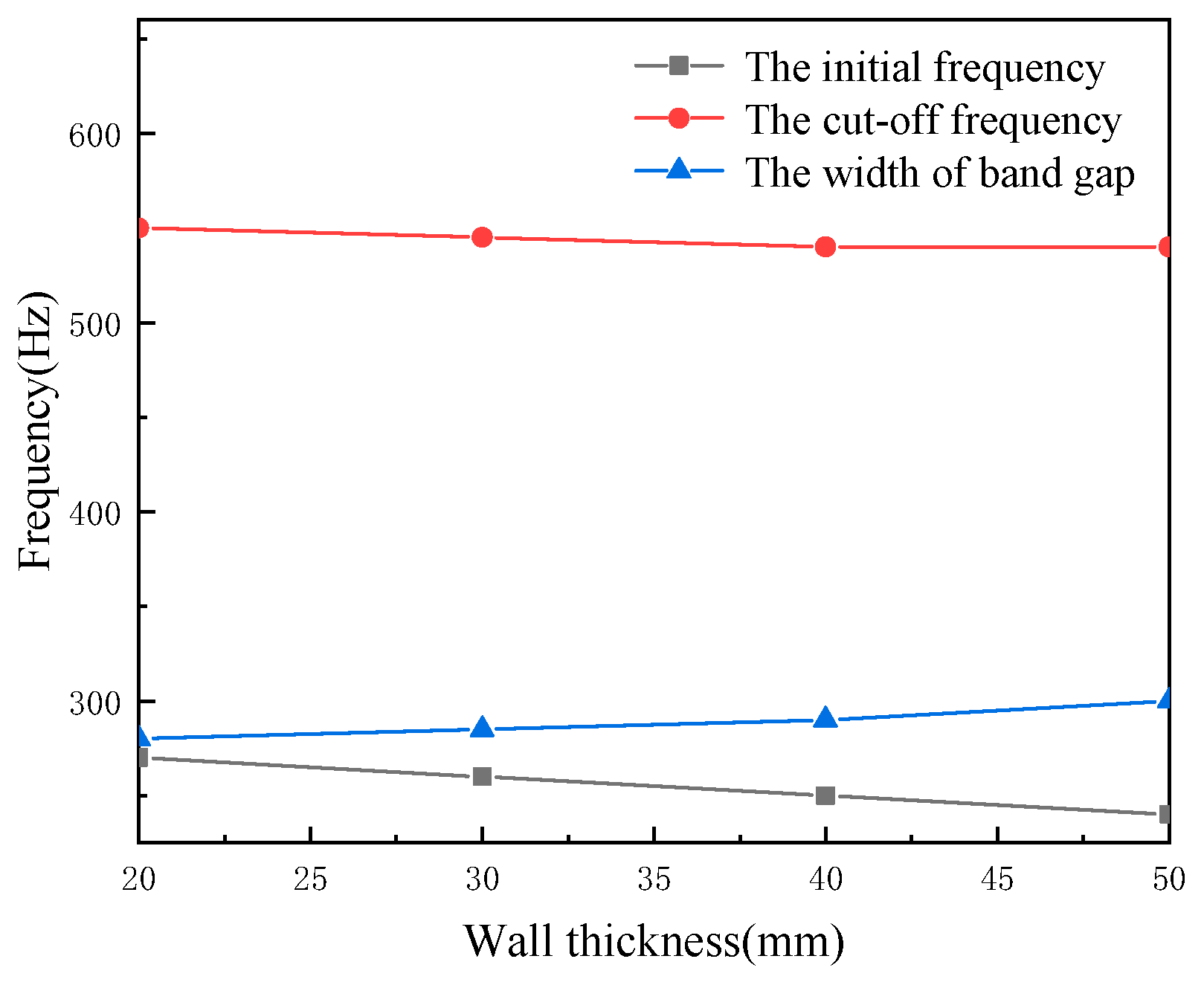




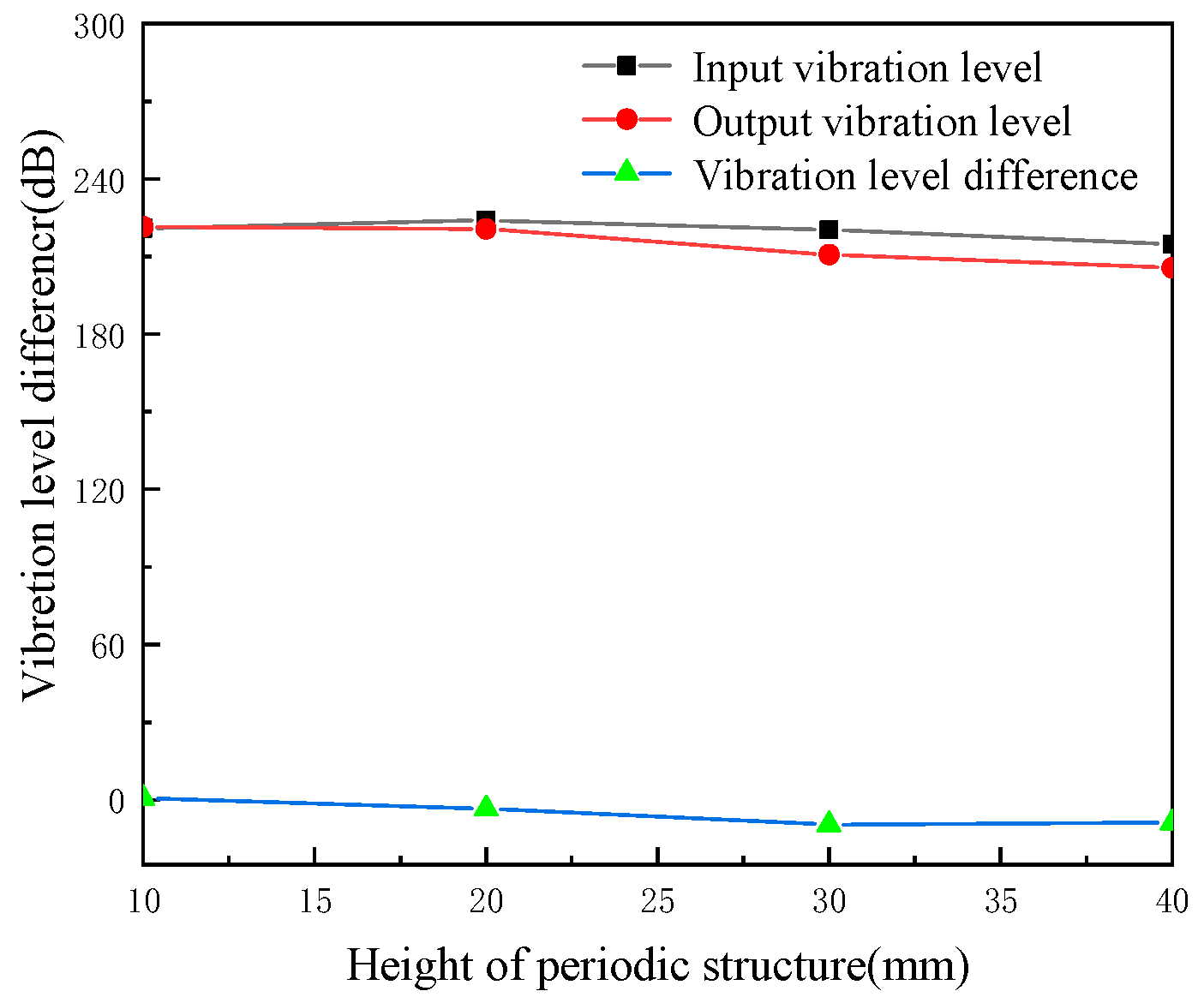
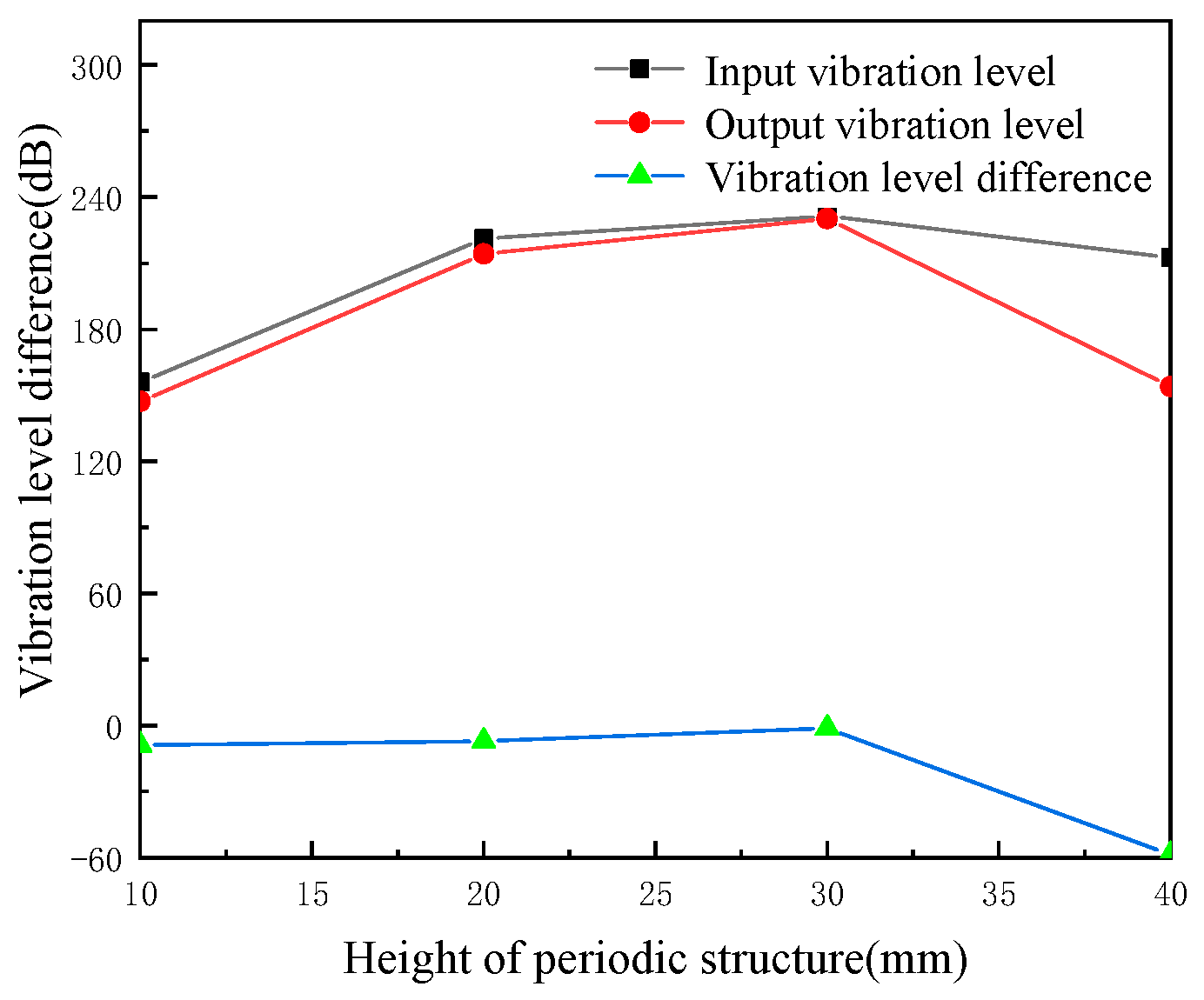
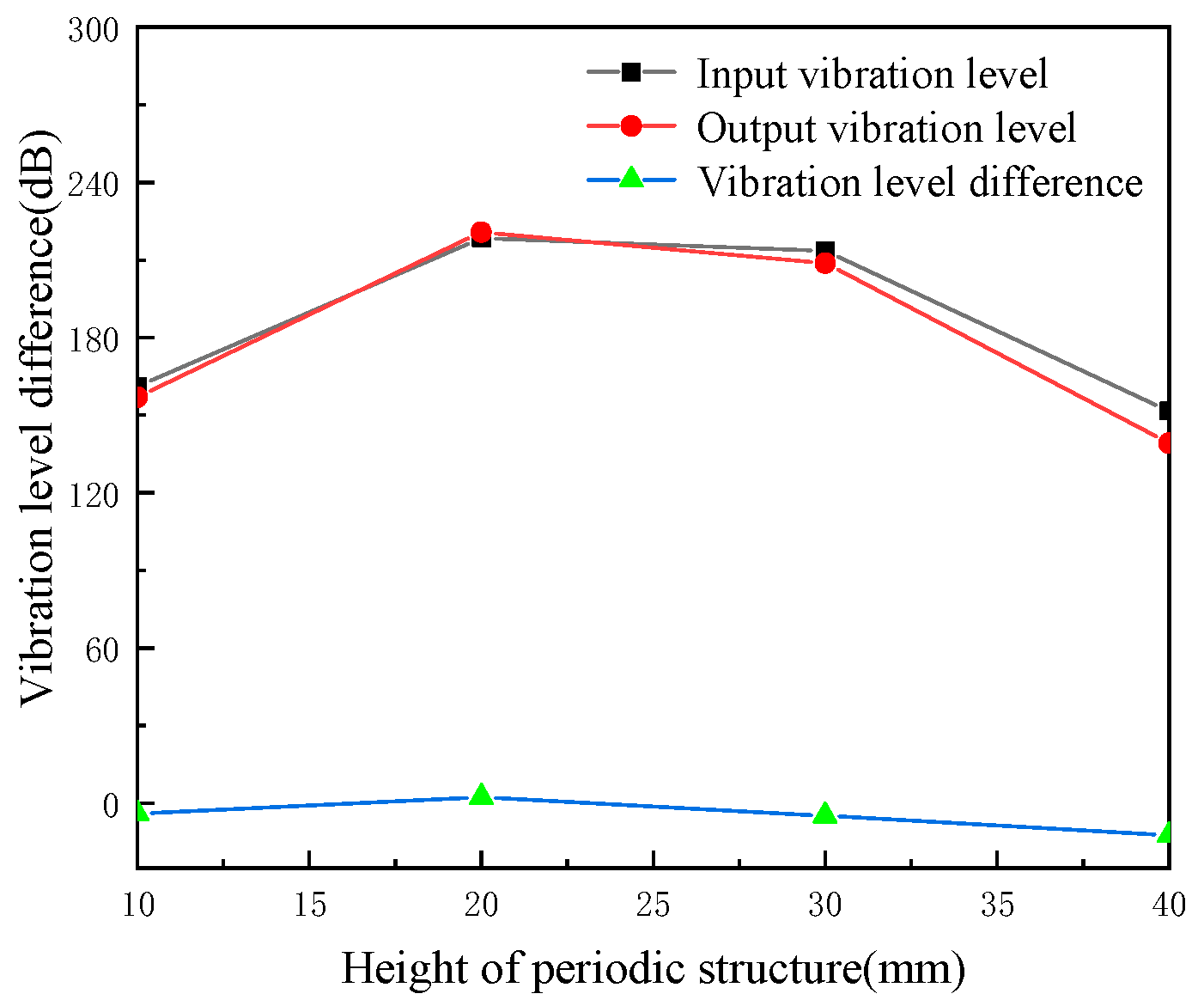
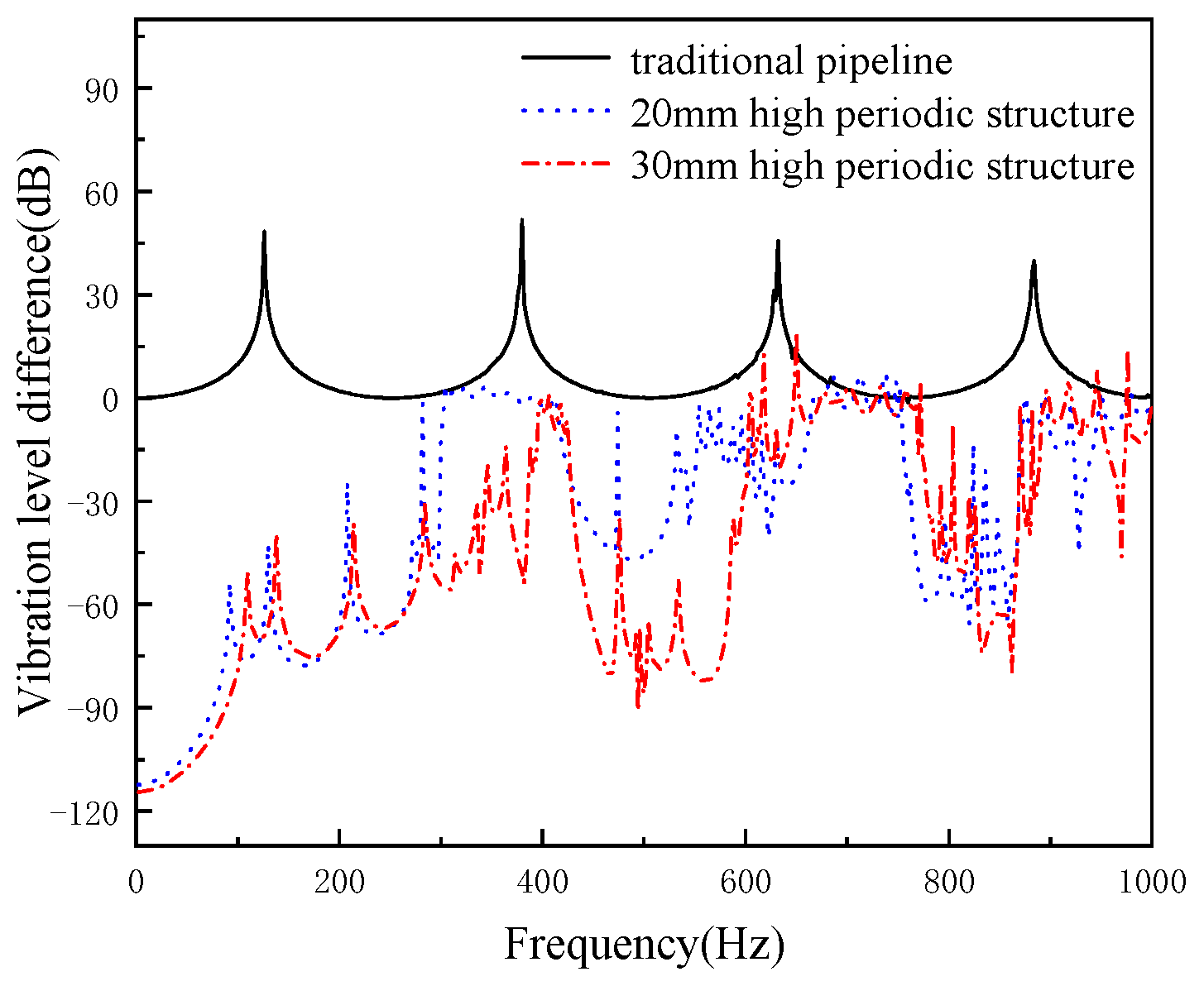


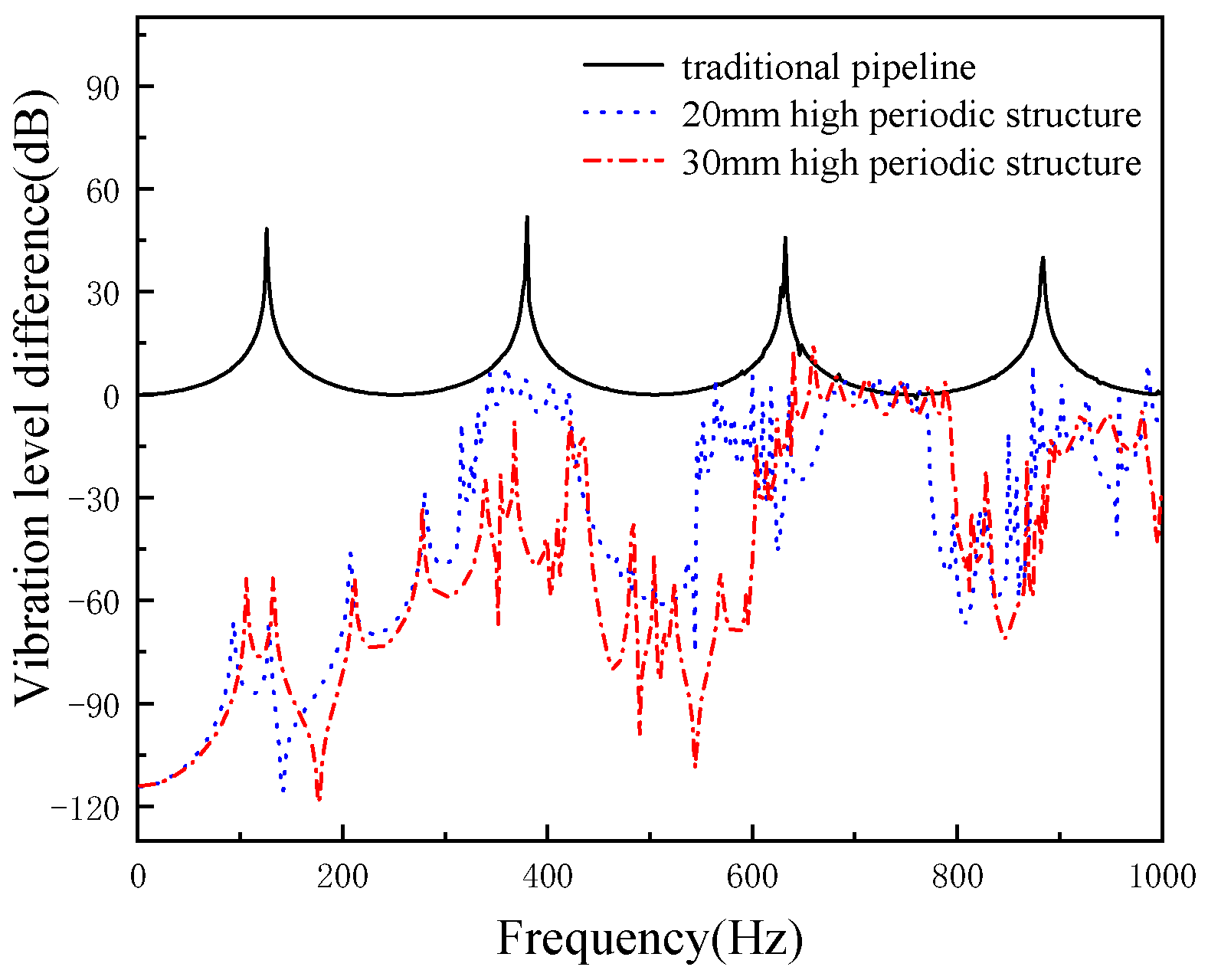
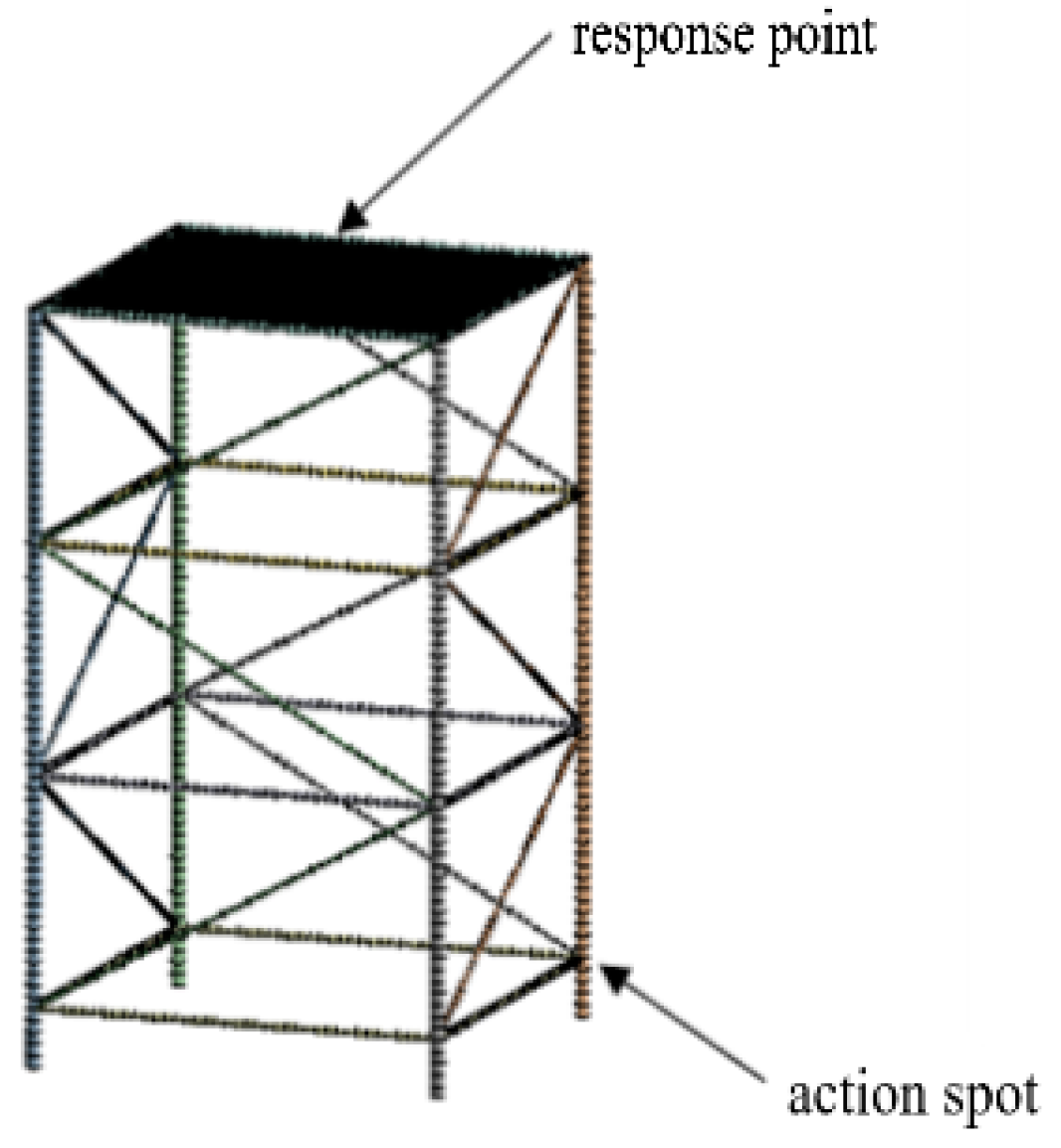

| Material | Density (kg·m−3) | Modulus of Elasticity E (Gpa) | Poisson Ratio |
|---|---|---|---|
| steel | 7850 | 200 | 0.3 |
| aluminum | 2700 | 70 | 0.33 |
| Epoxy resin | 1180 | 4.35 | 0.38 |
| Material | Density (kg·m−3) | Modulus of Elasticity E (Gpa) | Poisson Ratio |
|---|---|---|---|
| steel | 7850 | 200 | 0.3 |
| Height (mm) | Width (mm) | Input Terminal Vibration Level (dB) | Output Terminal Vibration Level (dB) | Vibration Level Difference (dB) |
|---|---|---|---|---|
| 10 | 40 | 220.88 | 221.46 | 0.58 |
| 20 | 40 | 224.08 | 220.59 | −3.49 |
| 30 | 40 | 220.33 | 210.70 | −9.63 |
| 40 | 40 | 214.62 | 205.67 | −8.95 |
| 10 | 60 | 161.16 | 156.99 | −4.17 |
| 20 | 60 | 218.40 | 220.72 | 2.32 |
| 30 | 60 | 213.59 | 208.73 | −4.86 |
| 40 | 60 | 151.54 | 139.18 | −12.36 |
| 10 | 80 | 156.04 | 147.2 | −8.84 |
| 20 | 80 | 221.14 | 214.15 | −6.99 |
| 30 | 80 | 231.42 | 230.21 | −1.21 |
| 40 | 80 | 212.61 | 154.02 | −58.59 |
| Traditional pipeline | 241.06 | 240.91 | −0.15 |
| Material | Inner Diameter (m) | Outer Diameter (m) | Quantity |
|---|---|---|---|
| Main pipeline | 1.2 | 1.25 | 4 |
| Horizontal pipeline | 0.66 | 0.7 | 16 |
| Inclined pipeline | 0.38 | 0.4 | 12 |
| Width (mm) | Input Terminal Vibration Level (dB) | Output Terminal Vibration Level (dB) | Vibration Level Difference (dB) |
|---|---|---|---|
| Traditional trusses | 146.70 | 145.12 | −1.58 |
| 10 | 150.72 | 148.32 | −2.40 |
| 20 | 150.65 | 148.24 | −2.41 |
| 30 | 158.76 | 152.02 | −6.74 |
| 40 | 155.37 | 149.59 | −5.78 |
| 50 | 154.61 | 146.74 | −7.87 |
| 60 | 154.74 | 146.82 | −7.93 |
| 70 | 155.37 | 147.59 | −7.79 |
| 80 | 154.63 | 146.77 | −7.86 |
Publisher’s Note: MDPI stays neutral with regard to jurisdictional claims in published maps and institutional affiliations. |
© 2022 by the authors. Licensee MDPI, Basel, Switzerland. This article is an open access article distributed under the terms and conditions of the Creative Commons Attribution (CC BY) license (https://creativecommons.org/licenses/by/4.0/).
Share and Cite
Lao, X.; Yu, Y.; Zhang, F.; Ye, J.; Xu, X.; Xia, Z. Research on Locally Resonant Characteristics of Pipelines with Periodic Structure. Micromachines 2022, 13, 850. https://doi.org/10.3390/mi13060850
Lao X, Yu Y, Zhang F, Ye J, Xu X, Xia Z. Research on Locally Resonant Characteristics of Pipelines with Periodic Structure. Micromachines. 2022; 13(6):850. https://doi.org/10.3390/mi13060850
Chicago/Turabian StyleLao, Xingsheng, Yonghua Yu, Fan Zhang, Jinxiao Ye, Xiangxi Xu, and Zhaowang Xia. 2022. "Research on Locally Resonant Characteristics of Pipelines with Periodic Structure" Micromachines 13, no. 6: 850. https://doi.org/10.3390/mi13060850





